The Article
SIX STAR FROM CONNECTED FIDELITY
2nd August 2024
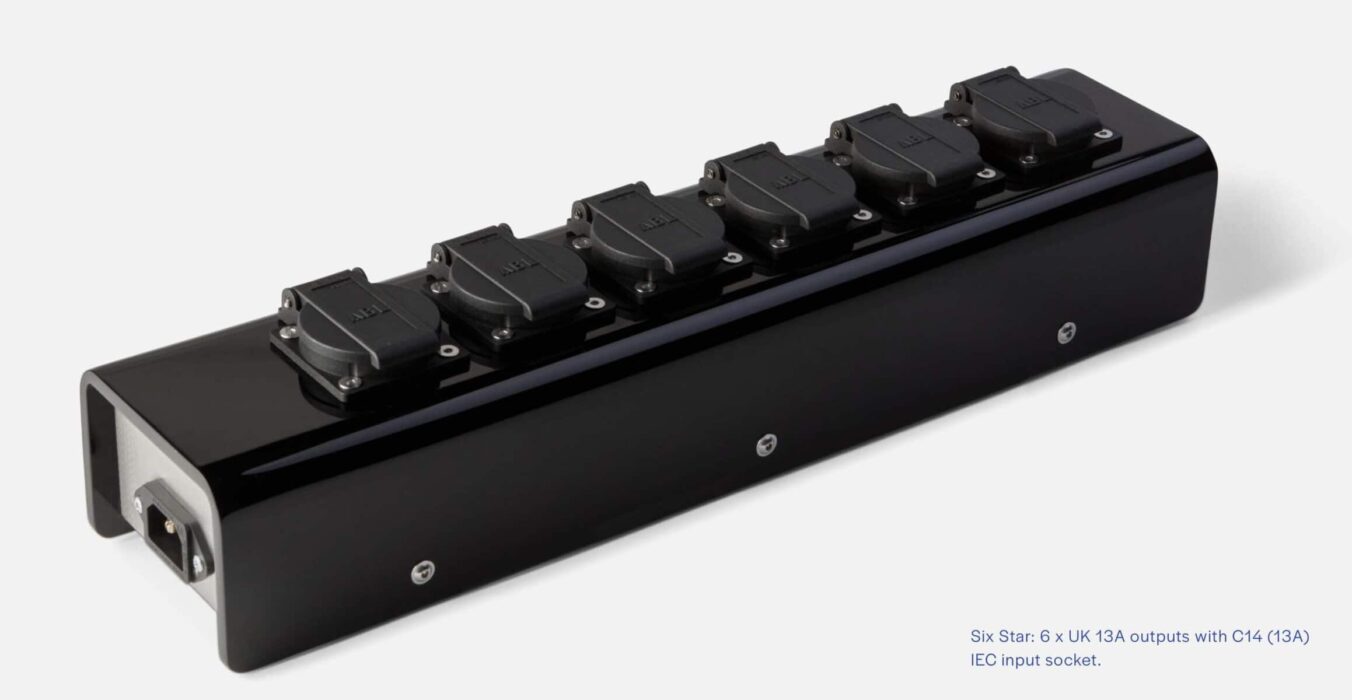
A new, star-wired power distribution block from this UK company, Paul Rigby plugs in, powers on, and drops down…to his listening chair
Connected Distribution? Not familiar? The man behind it is a quiet legend, Michael Osborn. He’s not the sort to shout and dance about, waving his arms for attention. Quite the opposite, in fact. And I happen to like that. It’s rare in this industry.
I first stumbled across Michael when he was running Astin Trew and you might be familiar with his CD player and amp under that banner too. I recall reviewing his hardware for HiFi World magazine, way back and liking them very much indeed.
Since, then I have reviewed his superlative balanced power supply and worked with him (in a journalistic/review capacity) as he introduced the rather wonderful Hana cartridges to these shores.
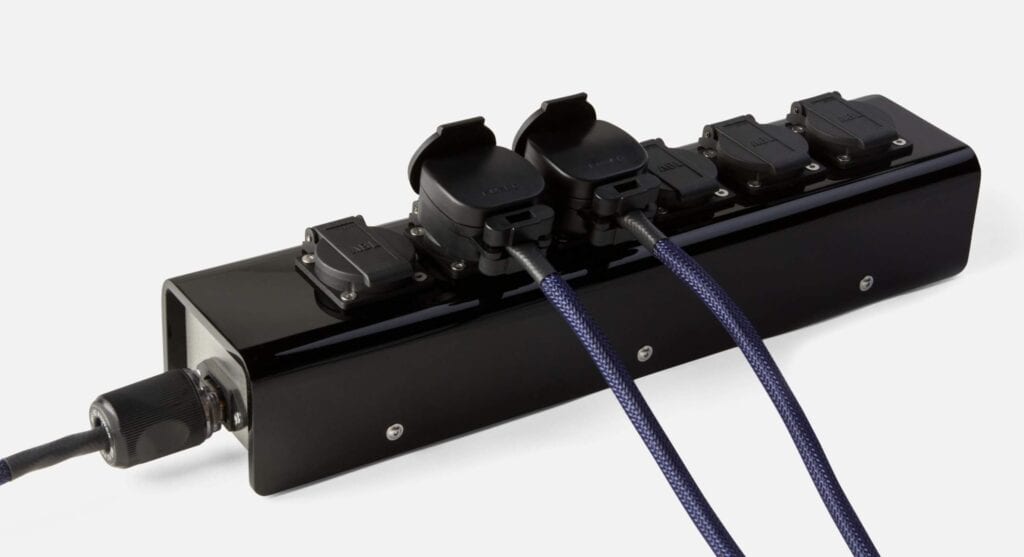
So, Connected Fidelity? Never fear. There’s quality behind them thar syllables.
Thus, if Michael says to me that he has a new power distribution block. And he has. Then I sit up and take notice because I know it won’t be anything run of the mill. And you know what? It isn’t.
This block offers six sockets (UK 13A or Schuko 16A) with optional active RFI filtering.
BALANCED POWER
And while I’m on the subject, lets get the review set up thing out of the way now and then we can talk about the build for the block itself, after that.
I decided to partly review this block off the back of a balanced power supply. That is, for the first part of the review, the balanced power supply sat between the wall and the power distribution block. Between the wall and the rest of my HiFi, in fact.
Why did I do this? Because I have tested HiFi, over the years, from a series of differing listening rooms in different locations around the UK. Some have been situated within noisy urban environments which was challenging and did not aid the review because I struggled against that background noise. Not actual car noise, babies crying and hydraulic drills but high-frequency noise, vibration and more.
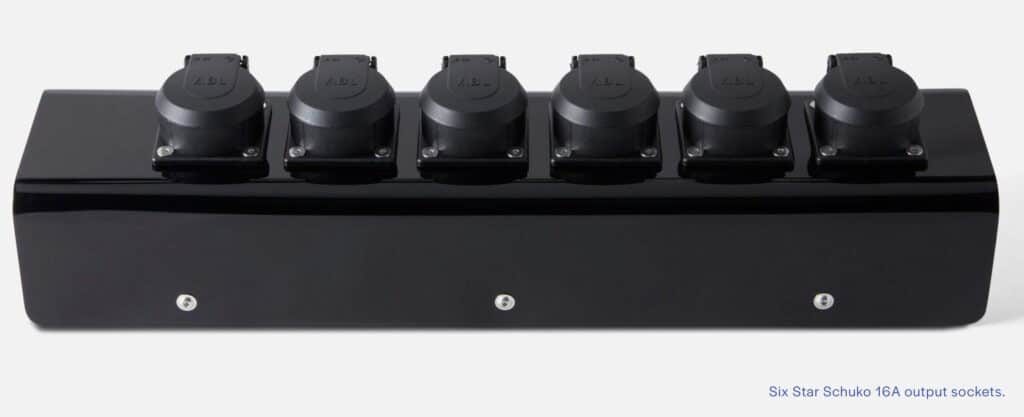
Others have been settled in an environment, so quiet, I could hear the wings of a moth fluttering via my HiFi system.
Where I am now? Well, somewhere in between.
This high-frequency noise variable(s) does affect HiFi reviews. Mine and others.
That is, I know how mains-related noise can skew, affect and bias a HiFi review. Your view of a HiFi component can be changed or at least influenced because of the overall noise floor of your room and where you live. And that ain’t good if you are trying bestow a judgement on a company’s HiFi box.
Inserting a balanced power supply into the chain, therefore, removes much of that aggressive and destructive noise. It allows you to better hear the hifi component under review, allowing you to hear that product’s pros and cons. A balanced power supply, removes much of the guess work from a listening session.
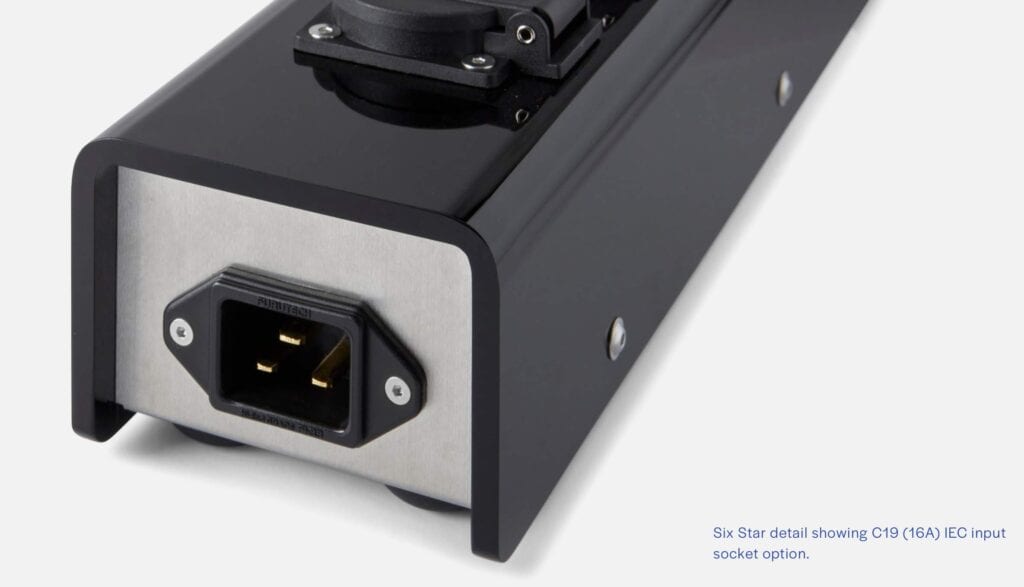
With a balanced power supply in place I stop asking myself, “Are the mids bright because of the review product? Or is it there because of mains corruption?”
With a balanced power supply in place, you don’t need an additional RFI filter (although mine did have one, see later). You can actually focus purely on the power distribution block itself, its parts and build quality and you are better able to judge the underlying tech. For this review? That’s what I wanted and needed.
Of course, if you’re looking to grab a power block yourself, you might not have a balanced power supply to hand. They aren’t cheap. Hence, opting for the RFI-filtered Star Six is a good idea to begin with (but again, before you decide, see later).
TECH TALK
The core of the Six Star is star wiring technology where multiple devices are connected to your central power source points. As the company explains, “Each power socket has its own dedicated direct connection to the power source point on the Live and Neutral line and direct earthing ‘star’ point as well. Hence, each device in your HiFi receives an identical level of power and the impedances (particularly important on the earth line) are identical for each powered component. This helps reduce both system hum and background noise.”
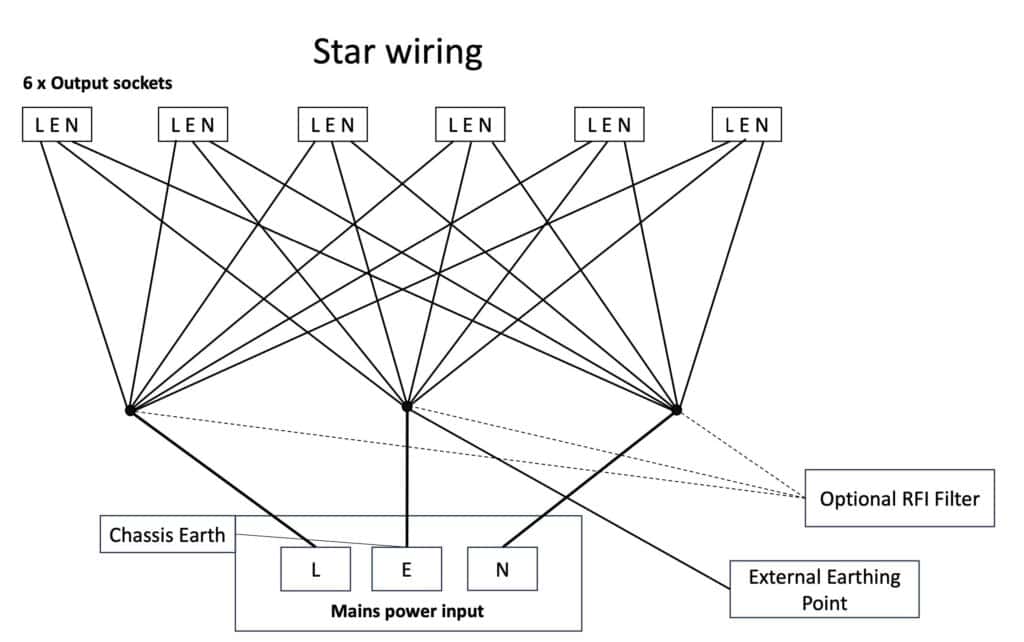
The block uses point-to-point wiring (no solder is used) while all power components and wires are cryogenically treated, Furutech is used for the terminations. The sockets are German made with sprung protective dust caps. At the end of the block is an external earth point to further lower the noise floor.
The whole thing is wrapped in a low resonance case using plastics (which acts as a damping material) and a non-magnetic stainless steel sub chassis. This also keeps the vibration levels very low.
Even the feet are different. Not the usual solid rubber but a bespoke design to better isolate the unit.
One of the key philosophies of this block is to remove all of the usual additional passive devices that many other power blocks use internally to lower noise. This unit, instead falls back on a “properly” configured star wiring system to do all of the work.
One specialist point, a bespoke point. My unit arrived with a RFI filter and a rocker switch (see image). Commercial versions do not include this switch. For myself as a reviewer? This switch allowed me to engage or disengage the RFI filter. So that I could try the unit under different configurations. For now? I turned the filter off.
So how did this unit perform?
SOUND QUALITY
I played an original pressing of Elton John’s Tiny Dancer from the album, an original pressing, of Madman Across the Water. I began the review with the balanced power supply in place.
My power chain has a particular pattern to it. That is, a mains cable runs from the wall into a balanced power supply. Another power cable runs to a Titan Eros (£750) power block. In that block are all my power amplifiers. That means my valve monoblocks and the power cables for my electrostatic speakers. Another mains cable runs from the block to a Chord Powerhaus M6 power block (£2,400). In the Chord, all of my front-end sources sit. That is, the pre-amp, CD transport, DAC, turntable and two-box phono amplifier. Actually, I’m now wondering if the phono amplifier should be sitting in the Titan but that’s one for me to muse over during this review.
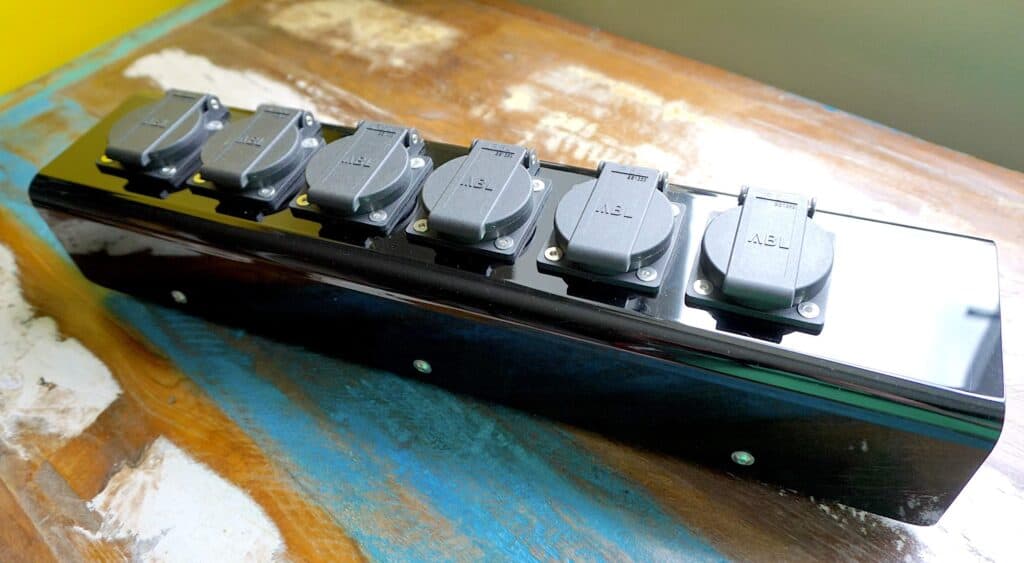
So, broadly speaking then, all of my power units are in one power block, all my front-end sources are in another. I also wondered if positional order of the blocks might be a factor. That is, if it mattered if the amplifier-loaded power block was the first to emerge from the balanced power supply. What if the front-end block emerged first? Again, something to ponder upon.
First test then? Put the Six Star in place of the Titan. That is, the Six Star carried all of my power amplification boxes.
So how did the Star perform in this mode?
My goodness, it sounded good. Smooth. Very, very smooth.
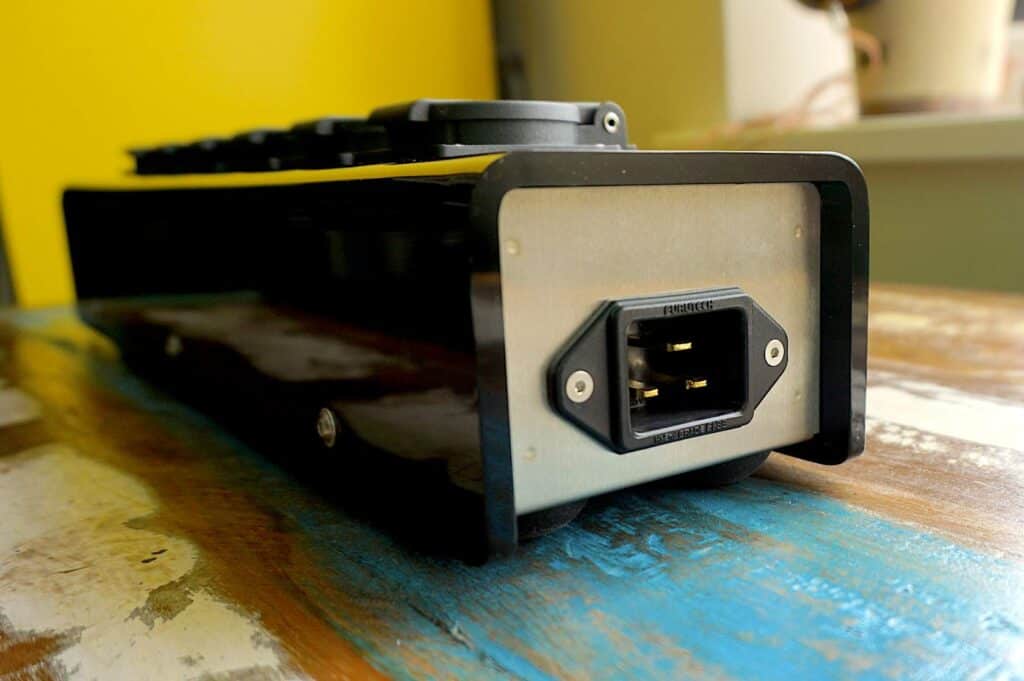
There will be some readers who will object to the above sentence (i.e. that a power block can ‘sound’ good) but what you have to understand is this, a top-quality powerblock doesn’t necessarily produce good or bad music in an of itself. Quality power blocks are enablers. They allow the music to sound good by looking after the house keeping. By removing high-frequency noise, by blocking RFI, by side-stepping vibration and more. Removing or blocking this rubbish and a lot more, a quality power block, waves on your music signal like a good traffic cop waves on the cars and trucks to keep the traffic moving smoothly.
That’s what a quality powerblock is, an experienced traffic copy, sitting in your HiFi.
And that’s what the Six Star did here, keeping all of the bad stuff out of the signal lane and allowing the music to pass by unharmed and undisturbed, allowing your ears – well, your brain – to bathe in quality sonics.
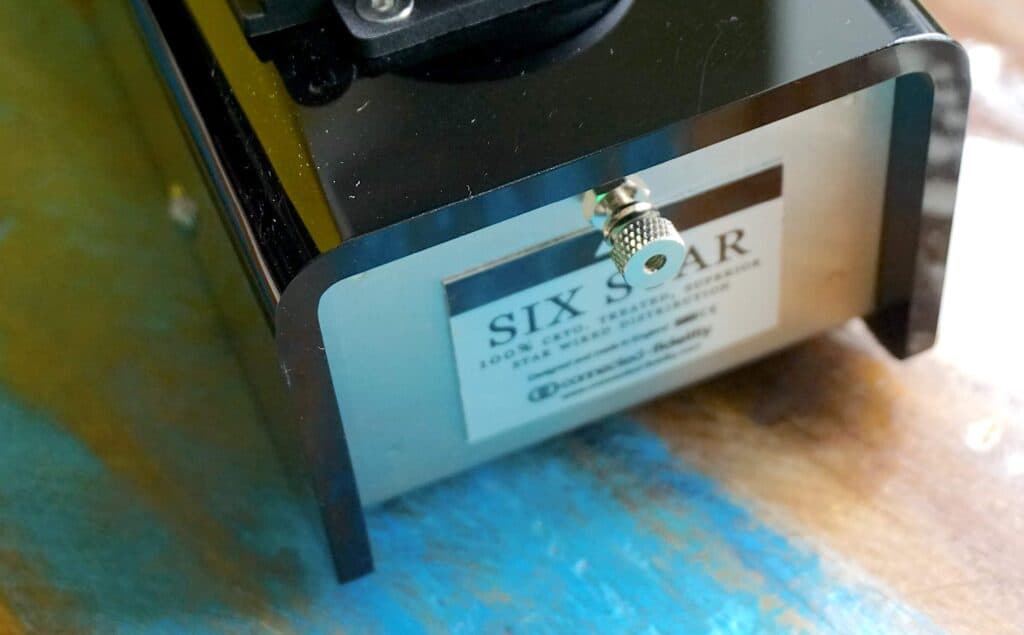
What the Six Star effectively did here was to create a spacious and airy soundstage. Treble was so fragile and delicate, touching my HiFi in any way would surely damage it. Cymbals had a lightness of touch and a certain elegance that tugged at the emotions and gave the track a welcome contrast.
Similarly, the resonance around the piano extended much further now, around the upper mids.
Elton John’s own harmonic double tracking now changed to a more complex arrangement, the occasional choral background sounded more like a group of voices instead of an amorphous lump, a slight edge around the lead guitar had gone completely now, the extra clarity around the bank of violins was stunning and the drums? Yes, let’s finally get to the bass shall we as I’m talking about the power section? The drums were hit with precision yet managed to offer that plump bass effect that is so typical of 70s mastering. And it sounded lovely. Just lovely. Oh and the bass guitar now made sense, I could better follow what that instrument was up to and why.
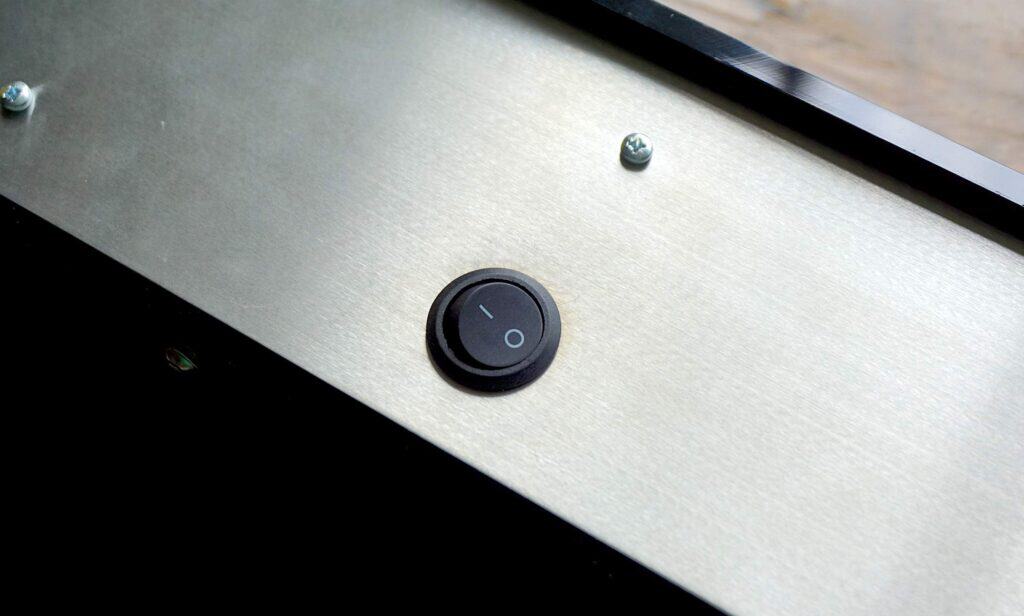
Next? I swopped the power blocks over, I put all of my front-end components into the Six Star, took the Chord out of the chain and this time the Six Star was one step away from the balanced power supply. So, I had the wall into the balanced power supply, from there into the Titan holding my amplification boxes and from there to the Six Star and the front-end gear.
The result? A leaner sound, I wondered if elements of that edge was creeping back a little. I also wondered, because my power blocks were fitted serially, if the Titan was basically feeding the Six Star with its own output. Effectively, degrading the sound a little before the Six Star got to grips with it.
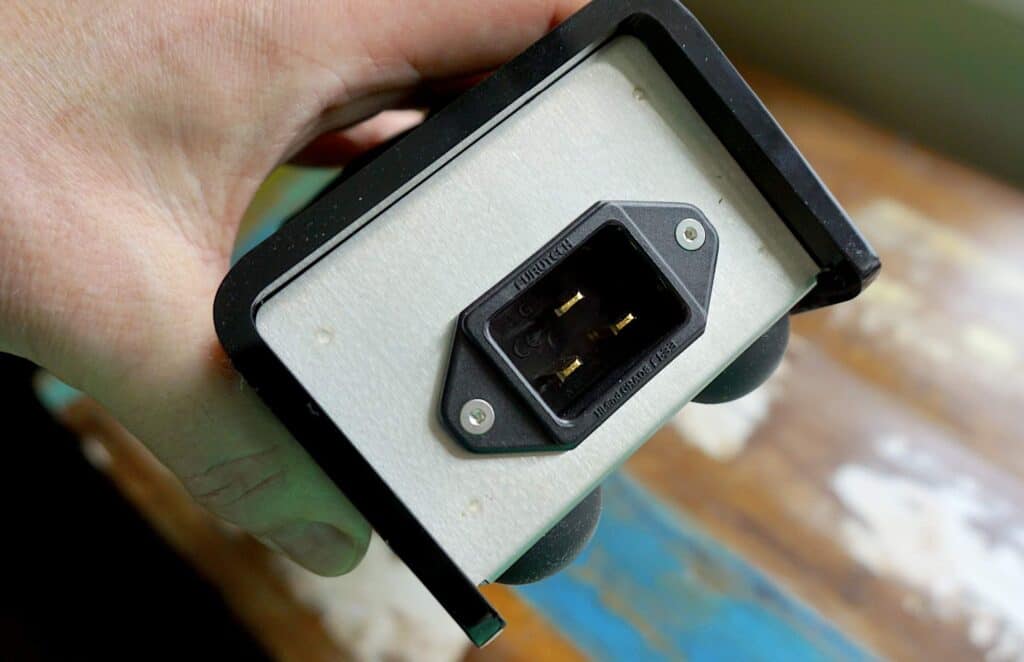
So I swopped the Titan for the more expensive Chord to see if that was a better option. To remind you, the balanced power supply was now feeding the Chord (and my amplification components) and the Chord was feeding the Six Star (loaded with front-end components).
In that configuration? The sound was much better. Although hey, it better had be for the price of the Chord, eh? I could hear a definite improvement in sound quality.
Even so. Even so. I actually preferred to have the Star connected next to the balanced power supply. I felt that noise fell even further when the Star was nearer to the source of the mains electricity. In my case, right next to the balanced power supply.
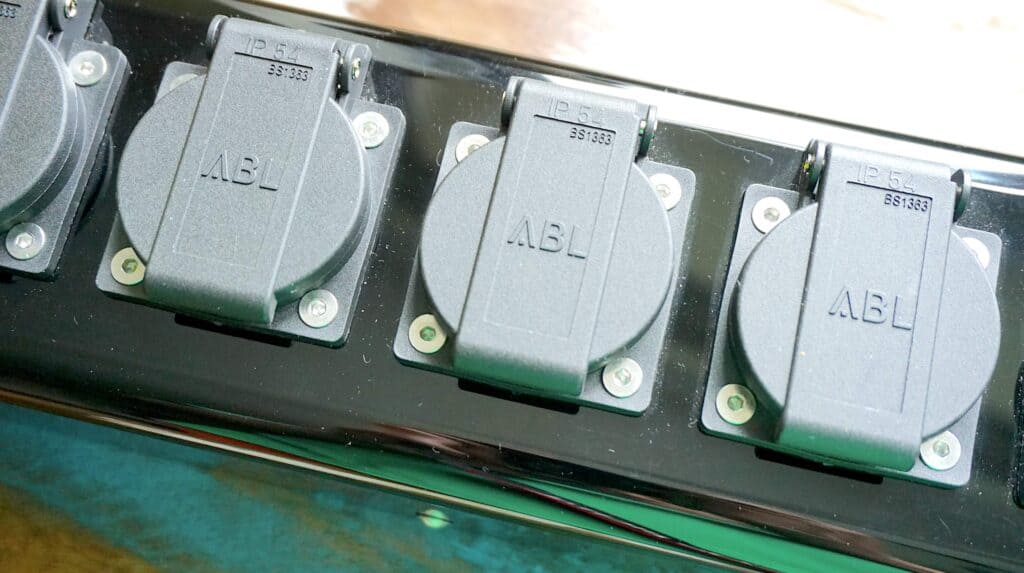
And that’s my conclusion in terms of positioning. If you do buy a Six Star and have more than one power block, the first thing the mains needs to see is the Six Star. Then anything else you might have connected should follow after that. It doesn’t matter what category of component is connected to it, power amplification or front-end source.
THE RFI FILTER
Next? I flicked the switch of my own Six Star to its RFI Filter mode. So filtering was now enabled, removed the balanced power supply from the chain entirely and plugged the Six Star directly into the wall. Trailing from the Six Star was the Titan Audio Eros. So from the wall emerged the Six Star with the power amp components fitted. From that the Eros trailed in series, holding the front-end sources.
I then compared the Six Star to the Chord which was already fitted with passive technologies to filter noise. The Chord is really designed to run from a wall, to be honest, not necessarily from a balanced power supply. So we were now in the Powerhaus’ territory here. So I swopped the Powerhaus with the Six Star and back again to attempt to come to some conclusions.
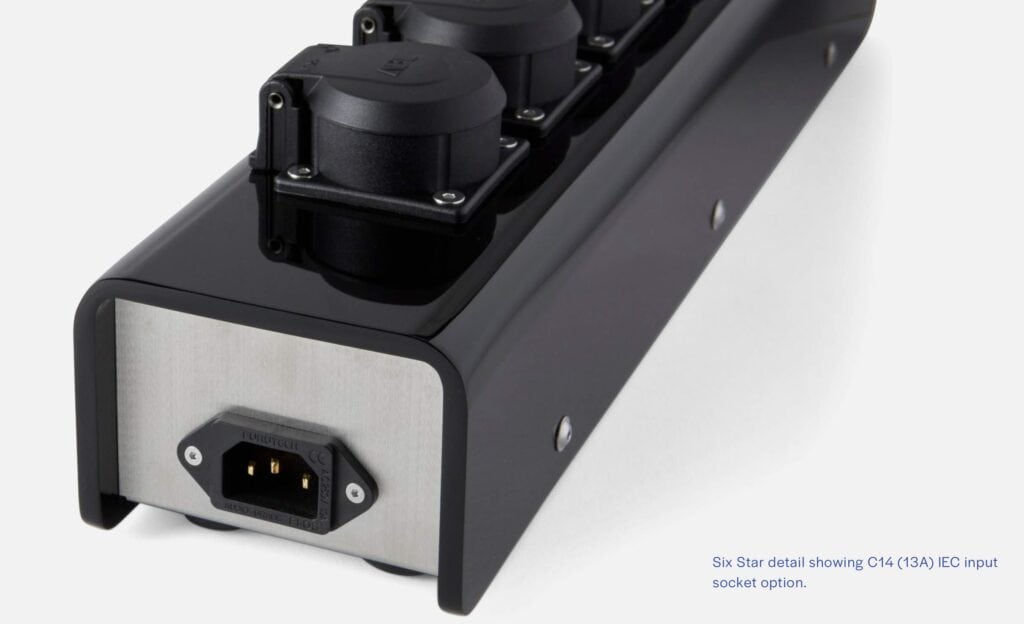
I returned to John Elton (Rowan Atkinson was right) and his Tiny Dancer track to see how the Six Star coped. I wasn’t expecting too much from the Six Star in this mode. After all, the Chord costs around three and a half to four times the price of the Six Star. Getting close to the Chord would give the Six Star a big thumbs up from me.
BIG BOY BATTLE
And the result? Well, this is interesting. In some ways, I’m reminded of the comparison between Rega turntables and those from Pro-Ject. The Six Star actually provides a better focus and precision around the mids and treble with a tight bass, responsive and agile. The Chord gives you a wholly balanced response with a bigger, heavier bass, slightly slower, less responsive but a little warmer too.
In terms of the noise floor? I would say that the Six Star reduced noise further, giving the vocals a cleaner presentation, better articulation, the piano is nippy, sprightly and light footed. Bass had a better structure from the Six Star, bass guitar was also easier to follow, for example.
And that’s what I hear from the turntables I mentioned, with Rega offering agility and precision up top and Pro-Ject offering bigger, meatier bass down below (broadly speaking). So take your pick from these power blocks to suite your own sonic bias.
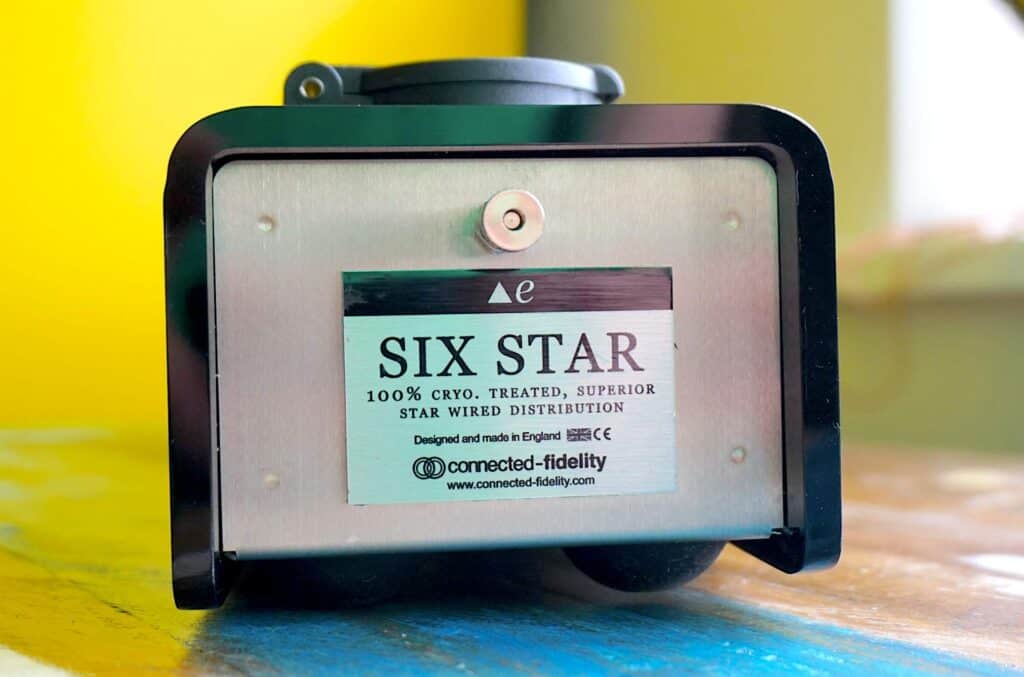
Even so, I was still shocked that the Six Star battled the Chord in its own backyard, went head to head and actually bettered it in many areas.
FILTER OFF?
I then – for the hell of it – kept the Six Star in the wall but turned off the RFI filter. Just to see what happened.
And you know what? The sound improved. It became smoother, more naturalistic, tonally more accurate. A tiny edge that occurred with the filter on, around the mids, disappeared. The lead vocal had a greater melodic flow, it rose and fell in a smoother, easier manner while the piano sounded richer.
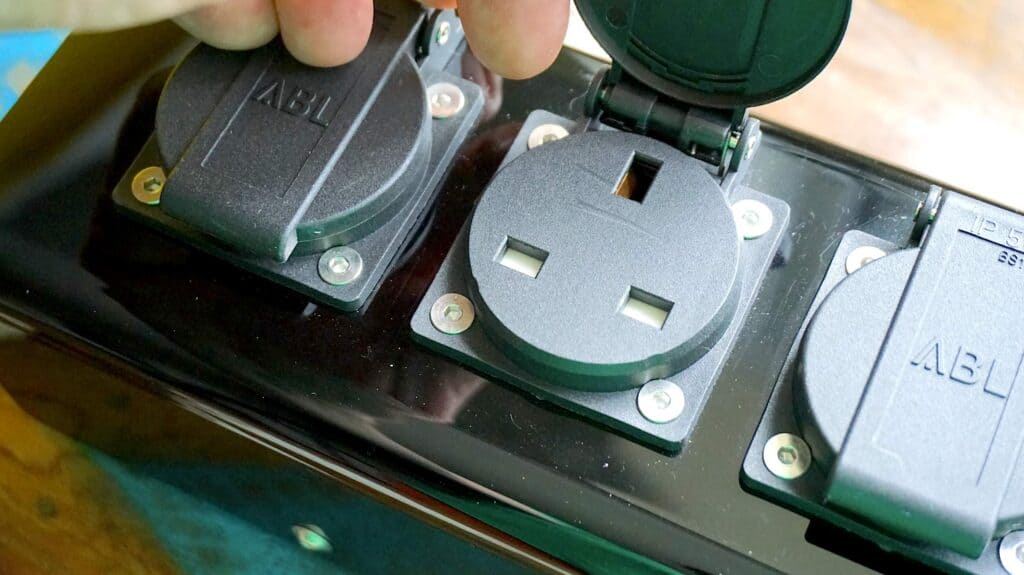
And I reckon that’s because of where I live. In terms of ‘noise’, I’m halfway between living in the middle of nowhere and an urban environment. So I can get away with no filter. If I was living in the middle of a city (and I have in the past, let’s not forget) then I think that filter would be invaluable. So choose the filter if you do live in the city. If you don’t? You don’t need one.
CONCLUSION
You know what? Ever since I moved into my new house around, what, nine months ago as I write this? I have been able to use my HiFi as a review tool, yes, but I have also been aware that the housing area I have moved into has been, electrically, noisier. I have also been irritated with my HiFi, on a low level, for those nine months because there has been a high-frequency upper mid/treble edge hanging around my system that I just couldn’t shift. I have tried everything to remove that.
The balanced power supply helped an awful lot but I could still hear edgy goings on in an around my music. Even with high-end anti-noise accessory components in place.
Hearing this sonic edge was the same as having an itch and not being able to scratch it. 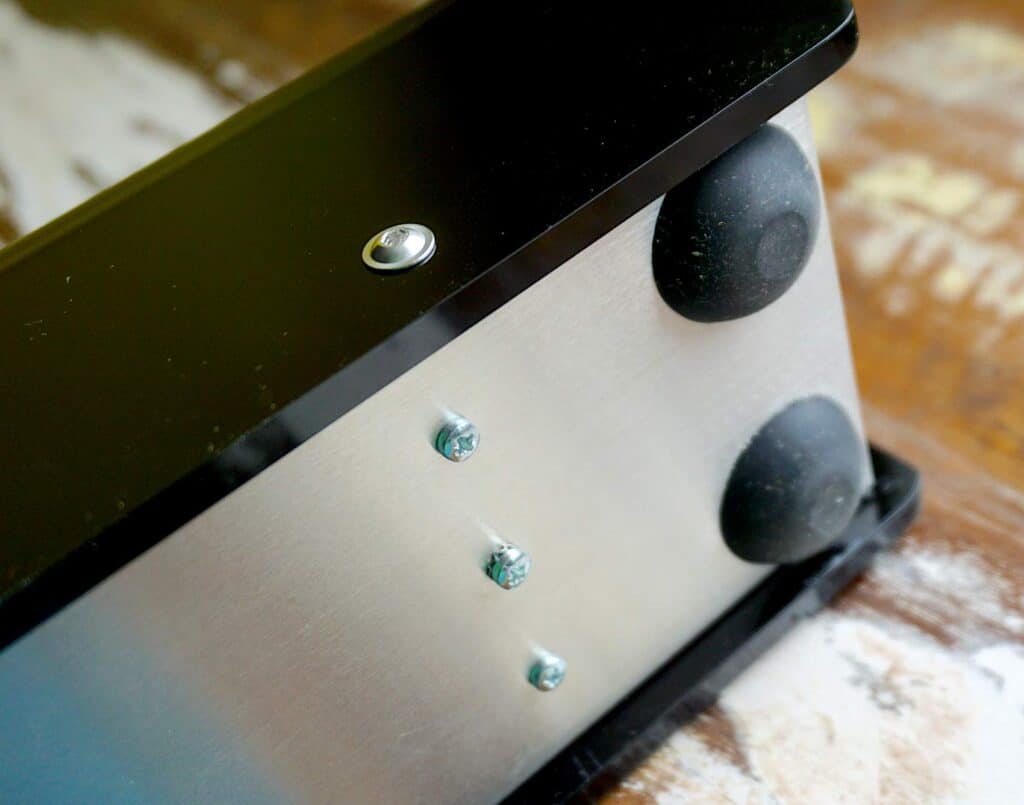
Well, consider that itch well and truly scratched because the Six Star has balanced my HiFi. Finally! Oh the relief! The relief! In short? The Six Star has removed the rubbish from the HiFi signal. Completely. Utterly. What is left is a beautiful sonic signal. The same beautiful sonic signal that I always knew my HiFi was capable of producing.
The Six Star has given my HiFi back to me and for that? I am eternally grateful.
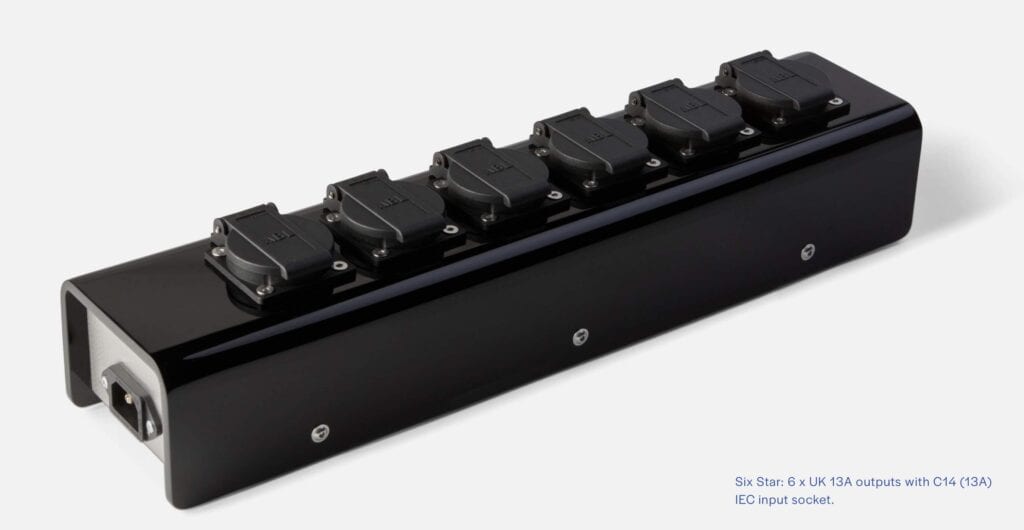
And one reason for that is the low-key, revolutionary design. A design that dares to be simple and pure and refuses to load up with passive components which are not only fashionable these days but de rigueur for any designer of a power block. Talk about going against the grain and swimming against the tide. But the result of this single-minded dedication? Stunning. The result here from the Six Star is sonically stunning.
So much in fact that I have no other choice but to give this box a full rating, 10/10 and a Golden Groovy. A rare honour indeed and the first time I’ve ever given such a rating to a ‘mere’ power brick. Let me tell you, this ain’t no ‘mere’ anything. Currently? It’s my new best friend.
CONNECTED FIDELITY SIX STAR
Price: £689 (with C19 IEC – without a RF Filter); £779 with a filter
£669 (with C14 IEC – without a RF Filter); £759 with the RF filter.
6S.16.13 6 x Schuko outputs with C14 IEC input £679
6S.16.16 6 x Schuko outputs with C19 IEC input £699
6US.16.13 6 x US outputs with C14 IEC input £679
6US.16.16 6 x US outputs with C19 IEC input £699
CABLE PRICES
UK.U1.1.0 UNITY ONE 1.0Mtr. UK13 Plug – C13 IEC £137.40
UK.U1.1.5 UNITY ONE 1.5Mtr. UK13 Plug – C13 IEC £161.40
UK.U2P.1.0 UNITY TWO 1.0Mtr. UK13 Plug – C13 IEC £504
UK.U2P.1.5 UNITY TWO 1.5Mtr. UK13 Plug – C13 IEC £582
Website: www.connected-fidelity.com
GOOD: low noise, design and build, tonal realism, balanced output
BAD: nothing at all
RATING: 10
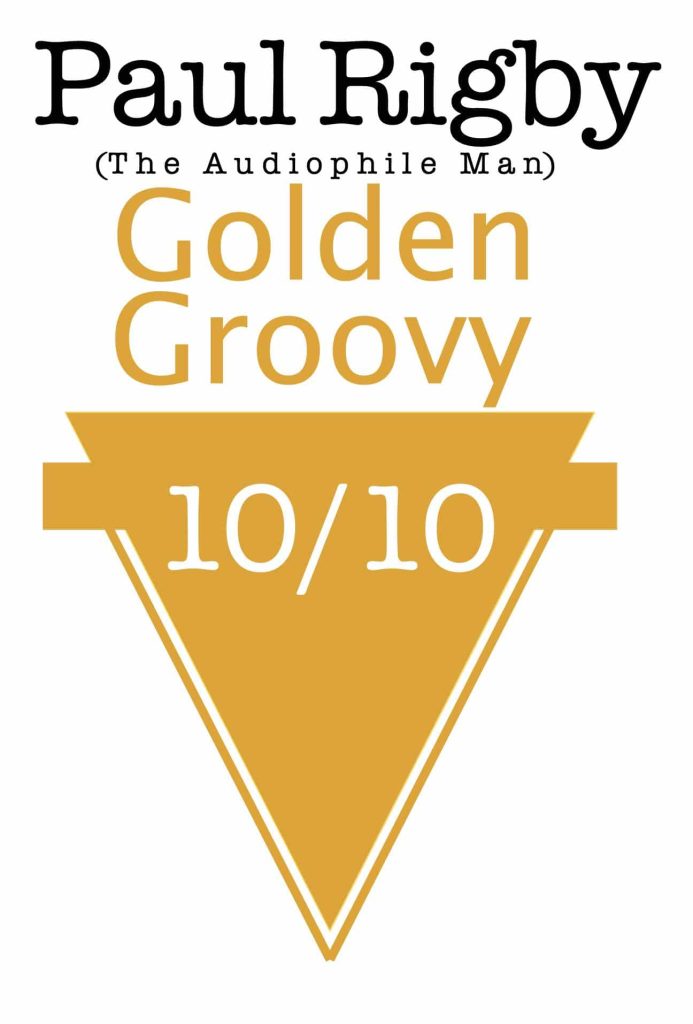
Don’t forget to check out my Patreon Page at www.patreon.com/audiophileman, for exclusive postings and more!]
REFERENCE
Origin Live Sovereign turntable
Origin Live Enterprise 12″ arm
Icon PS3 phono amplifier
Aesthetix Calypso pre-amp
Icon Audio MB845 Mk.II Monoblock Amplifiers
Quad ESL57 Electrostatic Speakers
Blue Horizon Professional Rack System
Harmonic Resolution Systems Noise Reduction Components


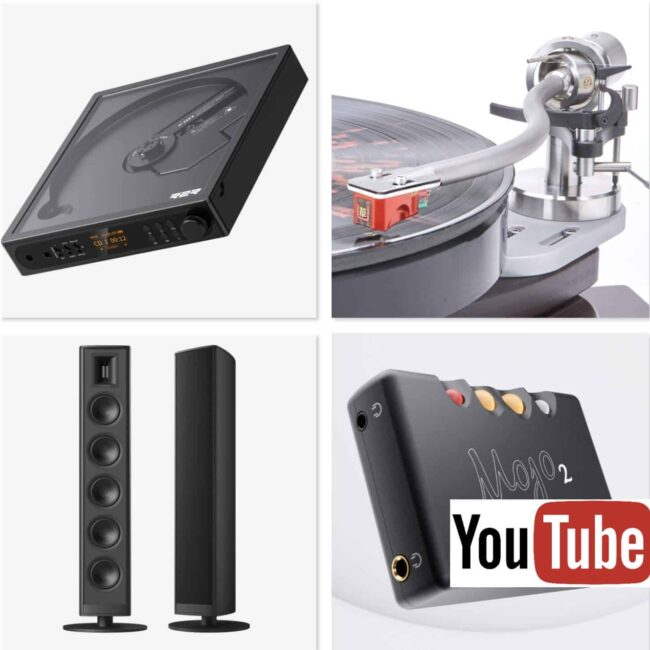
When you say the package price for both of the 16A C19 IEC and the Unit Two power cable is £759 is that right and if so where is that from? I had a quick search and couldn’t find that deal anywhere. Thanks for a great review!
Hi Stewart – yes, I think there has been a misunderstanding re. the prices here. Let me check it out and I’ll update ASAP
Right – I’ve updated the block pricing. I have cabling pricing here, just want to confirm that before I post again.
For the not so sure like me, is there a difference between a Mains Distributor like this item and a Mains Conditioner like my big Isotek Substation. Thanx!
Yes, indeed there is. When I lived in the city, I used many power conditioners including your big Isotek. In fact – can’t remember what it is called now – they used to be two large units both the size of your power station thing. You stuck them on top of each other, not sure if they still sell them. Both of them active units. Active anything does affect the sound in some respect ultimately that is why I stopped using power conditioners of any sort no matter the quality no matter the price (Power conditioners are ideal for urban environments though. I’m not knocking active systems but if you can get away without using an active system and I recommend doing so). With a much more passive less intrusive system there is less final influence on the sound quality. The six star power block is one of the more natural solutions. The sound is less, how can I put this, less ‘man-made’ if that makes any sense?
That’s a great answer Paul, thank you. I picked up my Isotek Substation years ago and when I moved to Berlin – also years ago – I kept it in my system to avoid swapping out my Isotek British mains cables. I live in a very urban environment and the unit has been running 24/7 for over 20 years. I like the review of the Power Block though so just checking if apples were oranges as it were. Greetings from Berlin